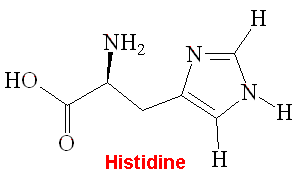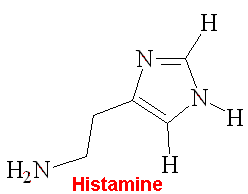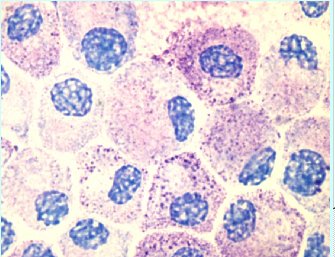Histamine in the body
In the body, histamine is synthesised by the enzyme catalysed decarboxylation of the amino acid histidine.




 It is then either stored, used in activating a receptor, or is broken down. Histamine is stored in several places around the body, mainly in special cells called mast cells (photo, right). These are found in abundance around areas particularly prone to injury, such as blood vessels and extremities. Histamine is also stored in a special type of white blood cell found in the blood stream called basophils. Histamine from these sources is used mainly as part of your body's immune system, where the histamine release is stimulated by Immunoglobulin E, a type of mammalian antibody. The antibody is triggered by a number of causes, usually an invading bacterium or virus, but it could also be a pollen cell or an allergic reaction to something the body has come into contact with. In any case, whatever triggers the release of the antibody results in the stored histamine being released into the body. This flood of histamine has a different effect depending upon which of the four known receptors it comes into contact with.
It is then either stored, used in activating a receptor, or is broken down. Histamine is stored in several places around the body, mainly in special cells called mast cells (photo, right). These are found in abundance around areas particularly prone to injury, such as blood vessels and extremities. Histamine is also stored in a special type of white blood cell found in the blood stream called basophils. Histamine from these sources is used mainly as part of your body's immune system, where the histamine release is stimulated by Immunoglobulin E, a type of mammalian antibody. The antibody is triggered by a number of causes, usually an invading bacterium or virus, but it could also be a pollen cell or an allergic reaction to something the body has come into contact with. In any case, whatever triggers the release of the antibody results in the stored histamine being released into the body. This flood of histamine has a different effect depending upon which of the four known receptors it comes into contact with.


